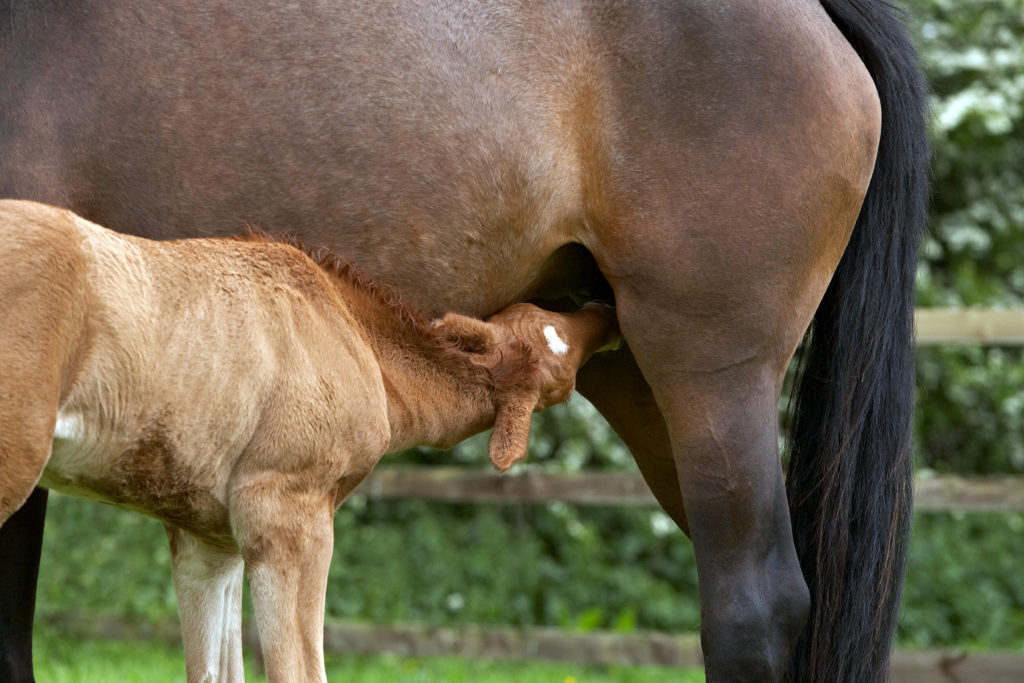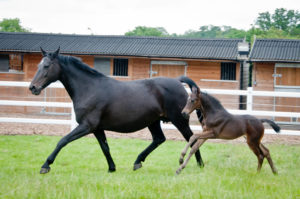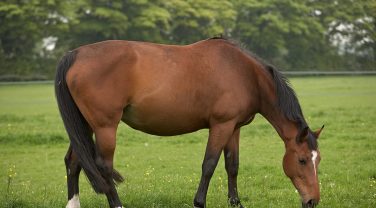Feeding Youngstock The Right Ration For Their Age
It is a long standing joke that only fools breed horses as it is rarely a profitable venture and is hugely demanding on your time and energy. However, if you have taken the decision to breed from your mare or are buying a youngster for the future, getting their nutrition right is vital and this starts with selecting the right horse feed for them by securing an appropriate youngstock feed and/or balancer. Ensuring an age appropriate, balanced diet may help to avoid some of the potential pitfalls that can occur when breeding horses, especially regarding nutrition.
The Newborn Foal
A foal is born weighing between 7% and 13% of its adult bodyweight – this is equivalent to a 70kg woman giving birth to a baby weighing between 5 and 9kgs or 10.7 to 20lbs! Bigger breeds tend to be a lower proportion of their adult weight when they are born (7%-10%) whereas Shetland ponies have been shown to be around 13% of their adult weight at birth. This is one of the reasons that bigger horses tend to take longer to mature and so may need more time to develop before they are ready for work.

One measure of growth rate is average daily gain (ADG) which simply relates to the amount of weight the foal gains on average each day. During the first 2 months a foal gains between 1.5 to 2kgs per day. Clearly this creates a huge demand for youngstock horse feed that contains the best energy and nutrients and at this time it is usually the mare’s milk that needs to meet this demand, this milk is of course the best feed for growing horses. A 500kg mare can produce between 10 and 17.5kgs of milk a day which is largely comprised of water and is why the lactating mare will drink a lot and should always have access to plenty of water. Interestingly, mare’s milk has a relatively low fat content with the White Rhino being one of the few species said to produce milk with less fat in it than horse milk. This probably reflects the fact that as an herbivore, the mature horse’s diet is naturally low in fat and so their metabolism has evolved to function on a carbohydrate based diet.
At the 2006 European Workshop on Equine Nutrition (EWEN) which focussed on the nutritional requirements of the broodmare and youngstock, a leading French researcher commented that “the period between 3 and 6 months is very sensitive for Developmental Orthopaedic Disease (DOD) as it is established that 67% of foals exhibit potential bone lesions which regress for most after weaning when feeding is correct and suitable exercise is provided.”
There are many factors that affect growth but clearly a balanced diet is essential to feeding a yearling horse, new-born horses and other young horses. The protein, vitamins and minerals supplied in the diet determine the strength and integrity of the structure of the horse. Tissues like bone, muscle and tendons all require a balance of these nutrients to be formed correctly. If the foal is overweight or growing too quickly then it is an indication that the amount of energy that is being derived from their feed should be reduced but it is vital that levels of protein, vitamins and minerals are maintained in line with their development.
A study carried out by Kentucky Equine Research (KER) in the USA showed that high blood glucose levels and the consequent high insulin response to a cereal based feed was associated with an increased incidence of DOD. The advice from the researchers was to reduce reliance on cereal based feeds for breeding and youngstock and use fibre and oil as energy sources instead.
How do I know if my youngster is growing too fast?
Contracted tendons or epiphysitis are clearly evidence of a problem but the aim is to try and spot a fast growth rate before clinical signs of DOD are apparent. Regularly weighing a youngster allows you to monitor ADG which can be plotted on a simple graph (see below): plot time along the bottom or x axis and weight up the side or y axis.

Plotting your youngster’s weight every couple of weeks will create a growth curve. This will help you in feeding your yearling horse correctly. If you see a very steep growth curve forming, you may want to reassess the diet, reduce energy intake, and consider changing the youngstock horse feed and sizes that you are using. In contrast, if the curve is very flat it’s an indication the foal isn’t growing very well which may indicate an underlying health problem or simply that the mare isn’t milking very well and so may require more feed.
Condition scoring foals is slightly different to adult horses in that when they are born, foals have very little body fat and so their ribs and the scapula for example, will be clearly visible. Within a few weeks they will begin to fill out and bony areas such as the point of the shoulder and the pelvic bones will have a smoother appearance and should look less protruding. Foals are slower to cover their ribs with fat and so don’t worry if you can see your foal’s ribs as they may still be in optimal condition. As long as they have rounded quarters and are developing a top line, visible ribs in foals shouldn’t be a cause for concern as it might be in the adult horse.
Growth spurts often mean youngsters can lose weight as they put their energy into growth. This needs to be addressed by increasing energy intake to ensure weight loss isn’t too great or that a lack of energy suppresses growth. The aim is to achieve as smooth a growth rate as possible with a youngstock horse feed that is carefully tailored to their current nutritional needs, including where applicable a youngstock balancer. If a youngster experiences a period of sub-optimal nutrition which is sufficient to slow their rate of growth, they will catch up as soon as they receive a higher plane of nutrition. This can result in what is called as “compensatory growth” and may result in a weaker musculoskeletal structure and delay maturation.
Weaning
Weaning is usually carried out at around 6 months of age which often means it occurs in the autumn months when grass quality is declining. This naturally helps to dry the mare off and gives her time to gain condition prior to having another foal in the spring. Between 3 and 4 months of age the foal’s digestive tract starts to develop the ability to gain more nutrition from fibre and so becomes less dependent on a milk based diet, this means that other youngstock horse feeds can be introduced. This is because it takes the foal time to build up a population of the micro-organisms it needs in the gut to digest fibre. Until this time the foal is really dependent on a milk-based diet and so weaning prior to 4 months of age is not ideal.
Most foals are sticking their heads in mum’s bucket within a few days of being born as they are naturally inquisitive to know what’s in the bucket! Getting them established on their own feed before weaning is important in helping to minimise weight loss post-weaning especially if this is happening in the autumn as the foal will start to use more energy for keeping warm.
Post Weaning
Most weanlings, yearlings and 2 year olds are out in the field for at least some of the day and so grass will be making a contribution to their nutritional requirements. When grass quality is good they may not need any additional energy from youngstock horse feeds to maintain their weight and growth but they do still need vitamins and minerals. Copper is an important mineral for growth as it helps to give tendons elasticity and a deficiency has been linked to epiphysitis. UK pastures are naturally very low in copper and so supplying a supplement or a youngstock balancer designed for breeding stock is advisable for all. This can be mixed in a handful of chopped fibre and fed alongside ad lib forage. This may be enough for breeds and individuals that are naturally good-doers all year round but lighter breeds may need some supplementary feed in the winter months or at other times if grazing is sparse.
Research suggests that reducing starch intake may be beneficial in reducing the risk of a number of problems including gastric ulcers and colic as well as DOD. Feeding a high calorie, chopped fibre feed such as one that combines alfalfa with oil, is a safer alternative to a cereal based feed but can still provide sufficient energy for a youngster. Fibre feeds with about 10% added oil contain around 12.5MJ/kg DE which is the same level of energy found in a traditional stud mix. All you need to feed alongside is a supplement or balancer to balance the diet.
At 3 years of age the growth rate has slowed sufficiently in most horses that they would be considered adults. The biggest Warmblood and Draft breeds may still need higher calorie and protein rations to help them fill out and finish growing but this can be achieved using adult conditioning feeds rather than stud rations. When starting to back any youngster, avoiding high starch horse feeds is usually beneficial for promoting good behaviour. This was backed up by a study supported by Dengie and carried out at the Royal Dick Vet school where it was found that horses on fibre and oil diets were less reactive to novel stimuli than those on cereal based equine feeds.
Show or Sales prep

If you are planning to show or sell your youngster, then it is tempting to put them on to a higher plane of nutrition so they carry extra condition that unfortunately still tends to be rewarded in the show ring. This is a decision that only you can make but you should be aware that by putting extra weight on immature joints and limbs you are increasing the risk of problems. The age at which you are doing this can also be significant. If you recall earlier in this article the researcher at EWEN mentioned the importance of exercise for avoiding growth problems in foals and research has shown that free range exercise – simply turning out in a field – is the best way to promote good bone mineralisation. Forced exercise where youngsters are walked in hand or are put on walkers, which is often used when “prepping” youngsters for sales, doesn’t create as good bone density and although not proven, is highly likely to increase the risk of problems later in life.
Whatever you choose to do with your youngster, investing in good quality nutrition and horse feeds that are well-tailored to youngstock in their formative years is likely to pay dividends in the years to come.



